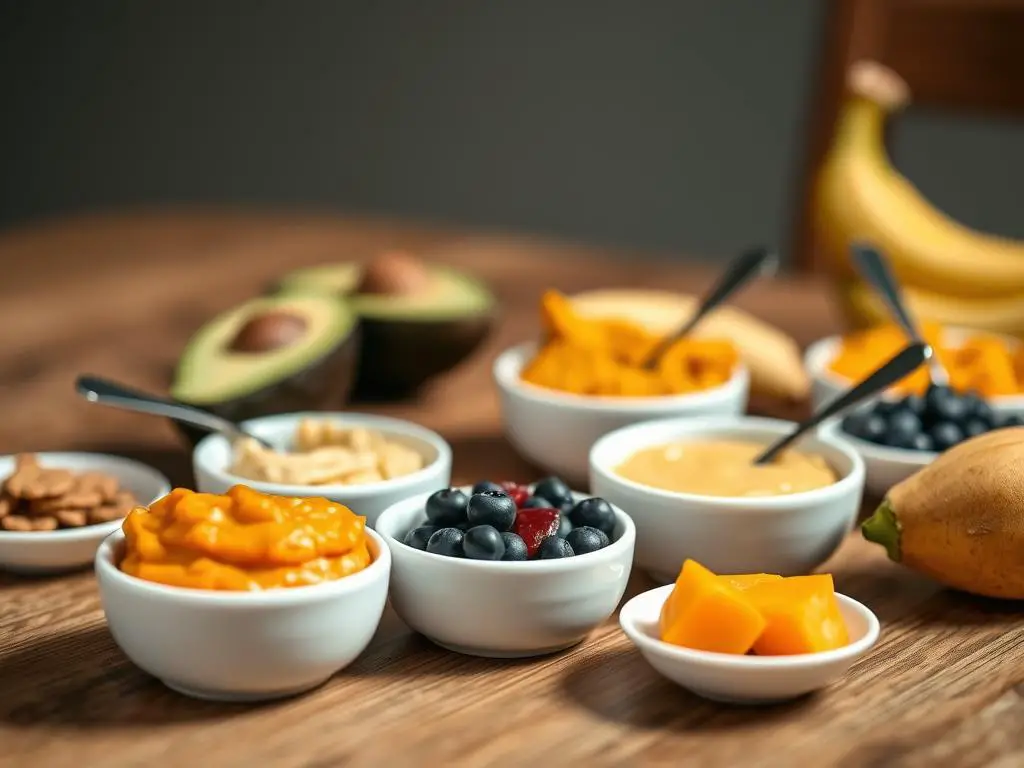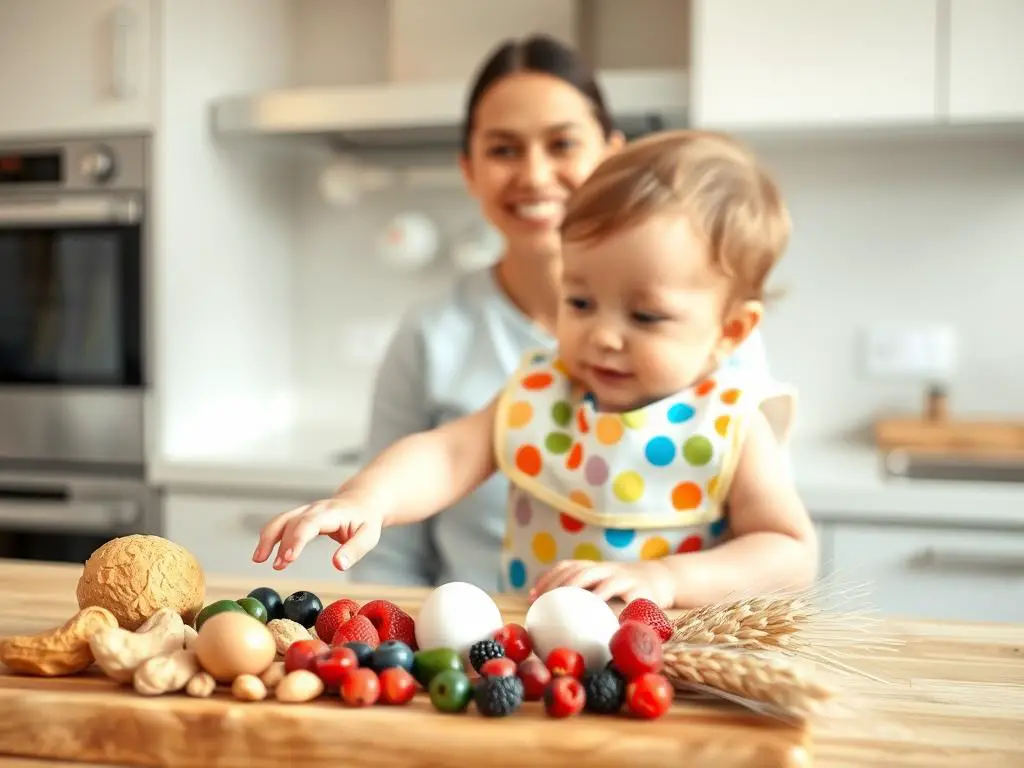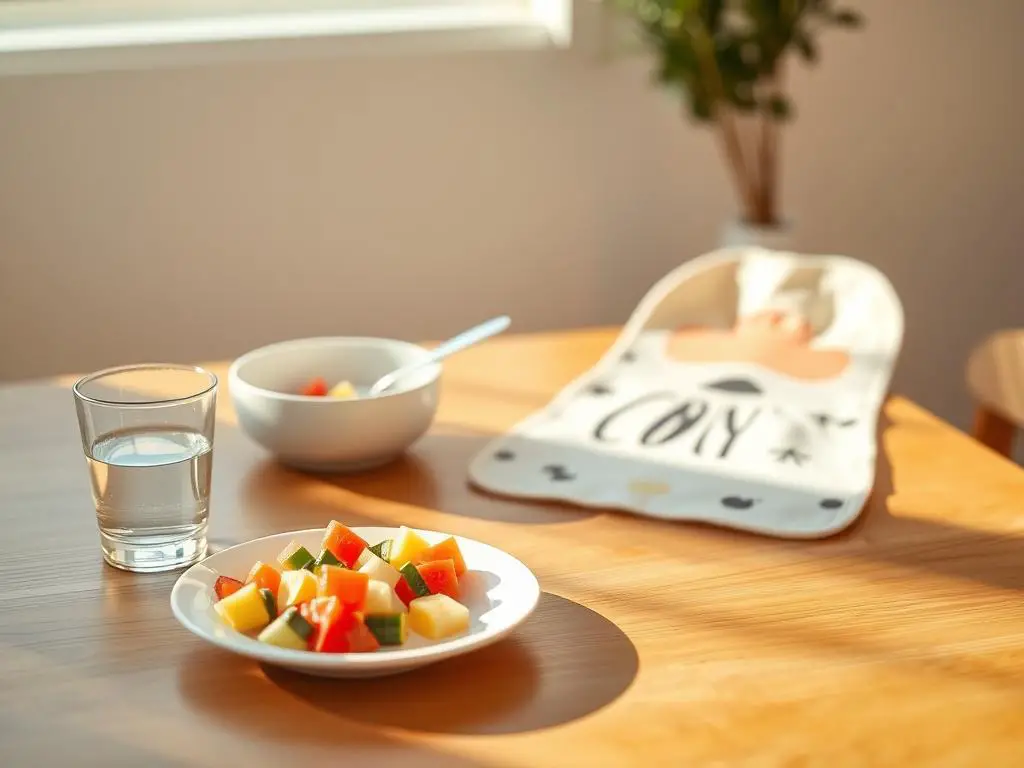What if the spoon in your hand could shape your child’s eating habits for life? Introducing solid foods to your baby is a big step. It’s a time when they start to explore new tastes, textures, and nutrients.
Introducing solid foods needs patience, knowledge, and the right approach. Every parent wonders when to start, what foods to give first, and how to make meals fun and safe. It’s more than just feeding them.
Your baby’s readiness, nutritional needs, and age are key in this journey. Choosing the right first foods and making mealtime positive are important. These tips will help you create healthy eating habits for your baby.
[This post may contain affiliate links. What does that mean to you? Well, if you click on a product and make a purchase, I may get some compensation from you at no charge. If you want to read the boring stuff my full disclosure can be found here.]
Key Takeaways
- Watch for readiness signs like sitting up independently and showing interest in food
- Start with single-ingredient foods and introduce new items every 3-5 days
- Progress gradually from smooth purees to more textured foods
- Create a consistent feeding schedule and positive mealtime environment
- Keep allergen introduction systematic and monitor for reactions
- Embrace the mess as part of your baby’s learning experience
- Stay patient and let your baby guide the pace of food exploration
Understanding the Right Time to Start Solid Foods
Deciding when to start solids is a big moment for parents. Most babies start eating solids between 4 and 6 months. Every baby grows at their own speed. So, it’s important to watch for signs to know when it’s the right time.
Signs of Readiness in Your Baby
Your baby will show clear signs when they’re ready for solid foods. Look for these key indicators:
- Sits upright with minimal support
- Controls head and neck movements steadily
- Opens mouth when food approaches
- Reaches for your plate during meals
- Lost the tongue-thrust reflex that pushes food out
Benefits of Introducing Solids Early
Starting solids early is good for your baby’s growth. Solid foods give important nutrients like iron and zinc. These nutrients are not found in breast milk or formula after 6 months.
Early food experiences help your baby develop taste preferences and chewing skills. They learn to accept different textures and flavors during this important time.
Recommendations from Pediatricians
The American Academy of Pediatrics recommends exclusive breastfeeding for the first 6 months. After that, start solid foods while still breastfeeding or formula-feeding. Dr. Steven Abrams from Dell Medical School says babies need complementary foods by 6 months for nutrition.
Most pediatricians agree that starting between 4-6 months is best. This depends on your baby’s readiness signs.
Choosing the Right First Foods
Starting your baby on solid foods is a big step. Choosing the right foods helps them develop good eating habits. Begin with simple, single-ingredient foods that are easy on their stomachs and packed with nutrients.
Best First Foods for Your Baby
Iron-fortified rice cereal is a top pick, providing iron babies need after six months. Sweet potatoes add natural sweetness and beta-carotene. Avocados are full of healthy fats for brain growth, and bananas offer potassium and natural sugars for energy.

Oatmeal is another great option. These foods are easy to digest, unlikely to cause allergies, and simple to make. A good choice is Gerber Organic Oatmeal Baby Cereal, which is iron-fortified and designed specifically for babies. Introduce one new food every three to five days to watch for any reactions.
Foods to Avoid Initially
Some foods are not safe for babies. Honey is a no-go for under twelve months because of botulism risks. Whole nuts, popcorn, and hard candies can cause choking. Also, avoid foods high in salt or added sugars because babies can’t handle too much sodium.
How to Prepare and Serve First Foods
Steam veggies until they’re soft enough to mash. Puree or mash foods to avoid lumps. Mix breast milk or formula with cereals for a familiar taste. These tips help make mealtime safe and fun. Always check the food’s temperature before serving—it should be lukewarm, not hot.
The Importance of Texture in Baby Foods
Texture is key when introducing solid foods to babies. As they grow, they can handle different textures better. Starting with the right textures helps them learn to eat and prevents problems.
A good feeding schedule should gradually introduce new textures. This supports their mouth development and encourages them to try new foods.
Progressing from Smooth to Chunky
Start with smooth purees around 6 months. These are great for beginners learning to swallow. By 7 to 8 months, move to mashed foods with a bit of texture.
At 9 to 10 months, soft lumps are okay. Your baby will be getting better at chewing.
| Age Range | Texture Type | Food Examples |
|---|---|---|
| 6 months | Smooth purees | Sweet potato puree, apple sauce |
| 7-8 months | Mashed foods | Mashed banana, avocado |
| 9-10 months | Soft lumps | Scrambled eggs, soft pasta |
When to Introduce Finger Foods
Look for your baby’s pincer grasp, which usually starts between 8 to 10 months. This means they’re ready for finger foods. Start with soft foods like steamed carrot sticks or ripe pear slices.
Tips for Safe Food Textures
Always check food softness by squishing it with your fingers. If it’s soft, it’s safe for your baby. Cut foods into strips to lower choking risks.
Make sure pieces are small but big enough to grasp. Steam veggies until they’re very soft. Offer ripe, soft fruits.
Creating a Balanced Diet for Your Baby
Creating a balanced diet for your baby is key to healthy eating habits. When starting solids, offer foods from all major groups. This means colorful fruits and veggies, whole grains, proteins, and dairy after one year.
Incorporating Fruits and Vegetables
Fruits and veggies are packed with vitamins and minerals for your baby. Start with simple purees like sweet potato, avocado, or banana. Then, introduce more variety with:
- Orange veggies: carrots, butternut squash, pumpkin
- Green veggies: peas, broccoli, spinach
- Soft fruits: pears, peaches, berries
Try mixing different colors and textures. This exposes your baby to various nutrients and tastes. It helps make them adventurous eaters who love healthy foods.

Importance of Iron-Rich Foods
Iron is crucial for brain growth and preventing anemia in babies. Include iron-rich foods like:
- Iron-fortified infant cereals
- Cooked lentils and beans (red lentils, mung dal, black beans)
- Mashed tofu (soft and easy to digest)
- Cooked and mashed green peas
Pair these with vitamin C-rich foods like oranges, tomatoes, or mashed strawberries to boost iron absorption naturally.
Diversifying Your Baby’s Diet Over Time
Introduce new foods every 3-5 days to watch for reactions and build taste preferences. Keep offering foods your baby doesn’t like, as they might take up to 10-15 tries to accept. Rotate proteins, grains, and produce to ensure your baby gets all the nutrients they need for growth.
Safe Eating Practices for Babies
When introducing baby to solid foods, safety is key. A safe eating area keeps your baby safe and makes mealtime fun. Knowing how to keep your baby safe makes this big step easier for parents.
Avoiding Choking Hazards
Some foods are not safe for babies. Always use a highchair and cut food into the right size. This helps prevent choking.
| Foods to Avoid | Safe Alternatives |
|---|---|
| Whole grapes | Quartered grapes |
| Raw carrots | Steamed carrot strips |
| Nuts and seeds | Smooth nut butters |
| Popcorn | Puffed rice cereal |
| Hard candy | Soft fruit purees |
Smooth Nut Butters
Nut butters are a great way to introduce protein and healthy fats to your baby (always thin with water, breast milk, or formula before serving).
- 👉 Try Pintola All Natural Peanut Butter Creamy Unsweetened — A 100% natural, unsweetened creamy peanut butter, perfect for mixing into cereals or spreading thinly on soft foods.
- 👉 Check out MyFitness Junior Chocolate Peanut Butter Smooth Spread — A smoother, kid-friendly option (use cautiously as it’s chocolate flavored; dilute before serving to babies).
🍚 Puffed Rice Cereal
Puffed rice cereal is light, easy to digest, and makes a safe first snack for little ones.
- 👉 Explore Bebe Burp Puffed Rice Porridge — A baby-friendly puffed rice option that’s gentle on tiny tummies and perfect for early mealtime transitions.
✨ Tip: Always introduce new foods one at a time and wait 3–5 days before adding another, so you can monitor for any allergies.
Supervised Eating: Why It Matters
Never leave your baby alone while they eat. Watching them ensures you can help if needed. Look for signs of trouble and stay close.
Temperature and Portion Control
Check food temperature before serving. It should be lukewarm. Start with small amounts and increase as your baby grows.
Introducing Allergens: A Step-by-Step Guide
Starting solids can be scary, especially when it comes to allergens. Research shows introducing allergens between 4 and 6 months can lower allergy risks. It’s important to know which foods to start with and how to introduce them safely.

Common Allergens to Introduce Slowly
When starting solids, some foods may trigger allergies. Introduce them one at a time, waiting 3–5 days before adding another. This makes it easier to identify reactions.
Key allergens to introduce carefully:
- Peanuts (smooth peanut butter thinned with water, breast milk, or formula)
- Tree nuts (almond, cashew, walnut in powdered or butter form — never whole nuts)
- Soy (tofu, soy yogurt, edamame)
- Wheat (soft chapati pieces, wheat porridge, or pasta)
- Dairy (yogurt, cheese — only after 6 months, and if family consumes dairy)
👉 Always introduce allergens in the morning when you can watch your baby closely throughout the day.
Introducing Common Allergens (Vegetarian-Friendly Options)
When you start allergen foods, always do it one at a time, in the morning, and wait 3–5 days before introducing another. Here are some safe vegetarian options with product picks parents can try:
🥜 Peanuts
Peanuts are one of the most common allergens, but introducing them early (in smooth, diluted form) may reduce risk.
- 👉 Try Pintola All Natural Peanut Butter Creamy Unsweetened — A pure, creamy peanut butter you can thin with breast milk, formula, or water for safe introduction.
🌰 Tree Nuts
Instead of whole nuts (which are a choking hazard), powdered forms or smooth nut butters are safer.
- 👉 Explore Alpino Natural Almond Butter — A smooth almond butter option for early exposure.
🌱 Soy
Soy is a plant-based protein rich in iron and easy to digest for babies.
- 👉 Try Mori-Nu Silken Tofu — Soft, silky tofu that blends easily into purees or finger foods.
🌾 Wheat
Wheat-based foods are often among the first grains babies try.
- 👉 Start with Nestlé Cerelac Wheat Infant Cereal — A baby-friendly fortified wheat cereal.
🥛 Dairy (if family consumes dairy)
Dairy provides calcium and protein but should be introduced only after 6 months.
- 👉 Begin with Nestlé Ceregrow Baby Cereal with Milk — A fortified cereal that combines grains with milk.
✨ Tip for parents: Always start with small quantities, watch closely for reactions, and consult your pediatrician if you notice rashes, swelling, or digestive issues.
Signs of Food Allergies to Watch For
Watch your baby closely for 2 hours after introducing new foods. Mild reactions include:
- Red, itchy rash or hives
- Swelling around mouth or eyes
- Runny nose or sneezing
- Mild stomach upset
Severe reactions need immediate medical help. Call 911 if your baby has trouble breathing, severe swelling, or becomes very pale or blue.
Recommendations on Timing for Allergen Introduction
The LEAP study found early introduction of peanut products can reduce peanut allergies by 80% by age 5.
Start with high-risk foods like peanuts and soy around 6 months.
Introduce one allergen at a time, at home, and in small amounts. Morning feedings are best since you can monitor your baby throughout the day.
Understanding Baby-Led Weaning
Baby-led weaning is a fun way to feed babies instead of using spoons. It lets them pick up soft foods with their hands and eat at their own speed. This starts when babies can sit up and hold things, making meals a fun discovery.
What is Baby-Led Weaning?
This method skips the spoon stage. Parents put soft food pieces on the baby’s tray. Babies then use their hands to feel different textures and tastes. This is different from spoon-feeding, where parents control the food.
Benefits of Letting Your Baby Self-Feed
Self-feeding through baby-led weaning has many benefits:
- It helps with hand-eye coordination and fine motor skills.
- It teaches babies to eat well and control their appetite.
- It helps prevent picky eating later on.
- Babies can join family meals right away.
- It saves time making special baby food.
Tips for Successful Baby-Led Weaning
Begin with foods cut into finger-sized sticks. Try steamed broccoli, ripe avocado, and soft sweet potato. Offer two or three foods at a time. Be ready for messes as babies learn by touching and tasting.
| Purees vs Baby-Led Weaning | Traditional Purees | Baby-Led Weaning |
|---|---|---|
| Control | Parent controls spoon | Baby controls intake |
| Texture Experience | Smooth consistency | Various textures |
| Motor Skill Development | Limited hand use | Active grasping practice |
| Meal Participation | Separate feeding times | Joins family meals |
Establishing a Routine Around Mealtimes
Creating a routine for your baby’s meals brings comfort and promotes healthy eating habits. A structured approach makes the transition to solid foods easier. Early consistent patterns lay the groundwork for lifelong positive food experiences.
Creating an Inviting Eating Environment
Your baby’s eating space is crucial. Pick a quiet spot, away from TVs and loud noises. Use bright, colorful plates and utensils to make meals fun. Keep toys off the table to help your baby focus.
Natural light in the dining area adds to the pleasant atmosphere. These tips help your child enjoy mealtimes.

How to Involve Your Baby in Family Meals
Bringing your baby to the family table strengthens bonds and teaches social eating skills. Place their highchair at table height to make them feel included. Let them watch family members eat and enjoy food.
Babies learn by copying, so seeing others eat vegetables often sparks their interest. Share safe foods from your plate when appropriate. This approach builds positive associations with family dining time.
Setting a Consistent Feeding Schedule
A regular feeding schedule for baby helps regulate hunger and creates predictability. Start with one solid meal daily around 6 months. Gradually increase to three meals by 9-12 months while continuing milk feeds.
Morning meals work well when babies are alert and happy. Space meals 2-3 hours apart to allow proper digestion.
| Age | Solid Meals | Milk Feeds | Best Times |
|---|---|---|---|
| 6-7 months | 1 per day | 4-6 per day | Mid-morning |
| 8-9 months | 2 per day | 3-5 per day | Morning & afternoon |
| 10-12 months | 3 per day | 2-4 per day | Breakfast, lunch, dinner |
Managing Messes During the Transition
Introducing solid foods to your baby comes with messes. They’re learning about tastes, textures, and moving their hands. Instead of worrying about spills, see it as a key part of their growth. The right tools and preparation make cleanup simple, letting your baby enjoy their discovery.
Preparing for Mealtime Cleanup
Being prepared can save you time and stress. Use a splat mat under the highchair to catch food. Keep wet wipes handy for quick cleanups. Have warm water and washcloths ready for face and hand cleaning. These tips can turn messy mealtimes into manageable ones.
Choosing the Right Feeding Gear
The right gear can make mealtime less messy. Look for these items:
- Silicone bibs with deep food catchers
- Suction plates and bowls that stick to the tray
- Easy-grip spoons designed for small hands
- Wipeable or machine-washable highchair cushions
Tips for Easy Cleanup After Meals
Quick cleanup tips can help you relax during meals. Wipe your baby’s hands and face right after eating. Rinse dishes quickly to avoid stuck-on food. Letting your baby play with their hands helps their motor skills. A positive view of messes encourages them to try new foods.
Observing Your Baby’s Reactions to New Foods
When starting solids, watching your baby’s reactions is key. Each baby is different, and their responses help you understand their likes and needs. This is especially true when introducing foods that might cause allergies.
Monitoring for Preferences and Dislikes
Babies show their feelings about food in many ways. A frown or pushing away the spoon doesn’t always mean they won’t like it. Studies say babies might need to try a new food 10-15 times before they like it.
Don’t give up if they don’t like something at first. Keep offering it in different ways. Try mixing veggies with fruits or roasting instead of steaming to change the taste.
Keeping a Food Diary for Insights
A food diary is a great tool during this time. It helps you track important details:
| Information to Record | Why It Matters |
|---|---|
| Food offered and time | Identifies patterns in acceptance |
| Amount consumed | Tracks nutritional intake |
| Reactions and behaviors | Spots allergies or intolerances |
| Texture preferences | Guides meal preparation |

When to Consult a Pediatrician
If your baby consistently refuses food, isn’t gaining weight, or shows signs like rashes or vomiting, call your pediatrician. These are signs that need a doctor’s check-up to make sure your baby stays healthy.
Encouraging a Positive Attitude Towards Food
Starting a healthy relationship with food is key for your baby. Whether you go for baby-led weaning or spoon-feeding, fun meals are crucial. This makes your baby curious and confident about trying new tastes and textures.
Making Mealtimes Fun and Engaging
Turn meals into fun adventures. Sing songs about the food or arrange fruits and veggies in colors. Rainbow plates with sweet potatoes, peas, and berries grab attention. Use fun plates from Munchkin or NumNum to make it special.
Stay positive by smiling and talking about the food. This method works for both baby-led weaning and purees, encouraging exploration without stress.
Involving Siblings in the Process
Older kids can be great role models during mealtime. Let them show off their favorite foods or how they use a spoon. Give them special jobs like:
- Choosing the vegetable to serve
- Helping arrange food on the baby’s plate
- Leading mealtime songs or counting games
- Sharing their favorite healthy snacks
Celebrating Small Milestones in Eating
Every new food is worth celebrating. Clap when your baby tries a new food, like banana or a new puree. Take photos but don’t use sweets as rewards. Simple praise like “You tried broccoli!” helps without creating bad food habits.
Common Challenges and How to Overcome Them
Introducing solid foods to your baby is full of joy and sometimes frustration. Every parent faces challenges during this time. Some babies are eager to try new foods, while others need more time and encouragement.
Understanding these common challenges helps you stay calm and find solutions. This way, you can make mealtime a positive experience for your family.
Dealing with Refusal to Eat
Your baby might push away the spoon or turn their head. This is normal. Many parents worry when their baby doesn’t want to eat the foods they’ve prepared.
Keep offering the same food without forcing it. Babies often need to see a new food 10 to 15 times before trying it. Make mealtime relaxed and let your baby explore at their own pace.
Sometimes, mixing refused foods with familiar favorites helps. This can make your baby more open to trying new things.
Sensory Issues with Textures or Tastes
Some babies gag on lumpy textures or refuse certain temperatures. Your child might love smooth purees but not like anything with chunks. Start by making tiny changes to texture over several weeks.
If your baby dislikes warm foods, try serving them at room temperature or slightly cool. Brands like Gerber and Beech-Nut offer various textures to help with this transition. Watch your baby’s reactions and adjust based on their comfort level.
Staying Patient During the Transition
Remember that each baby develops eating skills differently. Your neighbor’s baby might love avocado while yours prefers sweet potato. This variation is normal and healthy.
Keep mealtimes short and positive even when progress seems slow. If concerns persist beyond typical stages, consult with your pediatrician or a feeding therapist from organizations like the American Speech-Language-Hearing Association. They can provide specific strategies for your baby’s needs.
FAQ
When should I start introducing solid foods to my baby?
Babies are usually ready for solid foods between 4-6 months. Look for signs like sitting up and showing interest in food. The American Academy of Pediatrics suggests starting solids at 6 months, after breastfeeding.
What are the best first foods for baby?
Good first foods include iron-fortified rice cereal and mashed avocado. Also, bananas and oatmeal are great. Start with one food at a time, waiting 3-5 days before introducing another.
What’s the difference between purees and baby-led weaning?
Spoon-feeding purees is traditional weaning. Baby-led weaning skips purees, offering soft foods like steamed broccoli. Both methods are good, and many parents use both.
How do I introduce allergenic foods to my baby safely?
Introduce common allergens like peanut butter and eggs between 4-6 months. This can reduce allergy risk. Watch for signs of allergy and start with small amounts in the morning.
What foods should I avoid giving my baby?
Avoid honey, whole nuts, and hard raw vegetables. Also, skip whole grapes and foods high in salt or sugar. Always cut foods to prevent choking.
How do I create a feeding schedule for my baby?
Start with one solid meal a day, usually mid-morning. Gradually add more meals as your baby grows. Keep meal times consistent but flexible.
What should I do if my baby refuses to eat solid foods?
It’s normal for babies to refuse food sometimes. Keep offering without pressure. Try different ways of presenting food. Remember, milk is still a big part of their diet.
How can I tell if my baby is getting enough nutrients?
Keep a food diary to track what your baby eats. Look for steady weight gain and regular wet diapers. Variety in foods is key, especially iron-rich ones.
What are the best baby feeding tips for minimizing mess?
Use silicone bibs and a splat mat to catch spills. Choose plates and bowls that stick to the tray. Dress your baby in easy-to-clean clothes. Touching and exploring food is important for learning.
When should I be concerned about my baby’s eating habits?
If your baby consistently refuses food or isn’t gaining weight, talk to your pediatrician. Also, seek help if feeding causes stress for you or your baby.
